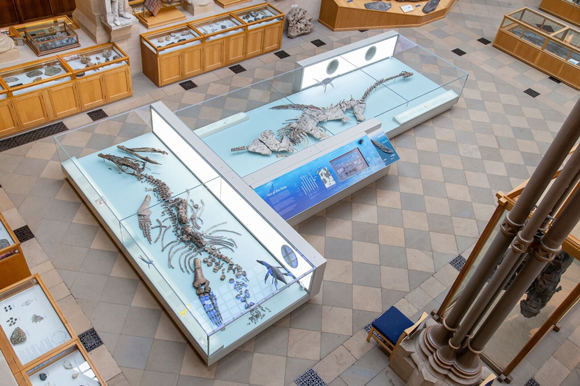In Praise of the Museum of Natural History (Oxford)
Oxford as the county town of Oxfordshire (England), has many attractions. It is of course, famous for its distinguished and highly respected university. It is one of the oldest seats of learning (alongside Paris and Bologna), in the western world. The Victorian poet Matthew Arnold (1822-1888), coined the phrase “the city of dreaming spires”, it is indeed a very awe-inspiring place with its beautiful architecture and stunning university colleges and buildings.
Oxford Museum of Natural History
However, Oxford should not necessarily just be the haunt of academics and students. For families, there is much to see and do in this historic part of England. Take for example, the Museum of Natural History, it is free to enter (donations are suggested) and it provides a fantastic day out for young and old alike.
A View of the Ground Floor of the Natural History Museum (Oxford)

Picture credit: Everything Dinosaur
The image (above) shows marine reptile fossils on display.
For models and replicas of marine reptiles and other prehistoric creatures: Prehistoric Animal Models and Figures.
Oxford Stunning Architecture
The museum acts as a centre for scientific study for the University of Oxford. It houses the University’s collection of palaeontological, geological and zoological specimens, including some of the very first dinosaur bones to be scientifically studied. This collection is housed in a stunning example of neo-Gothic architecture, the ornate columns and use of copious amounts of glass provides a wonderfully spacious and well-lit learning area. With visitor numbers estimated to be around 700,000 people a year, this well-laid out and beautifully appointed museum can get quite busy at times, but please note, the Natural History Museum (London), attracts approximately 5,000,000 visitors per annum. The London museum can get extremely congested, in contrast, the Oxford University Museum of Natural History (OUMNH), especially shortly after opening at 10 am tends to be much quieter.
Founded in 1860
Founded in 1860, that’s twenty-one years before the Natural History Museum (London) opened its doors, the OUMNH has maintained its strong tradition to inform and educate and helps to underpin a varied programme of scientific research as well as playing a significant role in teaching. The Museum provides an extensive array of family orientated activities and if over the course of the summer holidays, you have a few hours to spare this museum is well-worth a visit.
Look out for the cast of a male Tyrannosaurus rex, a life-sized model of a Coelacanth, some amazing fossil specimens, live insects and of course, arguably the OUMNH’s most famous resident – the remains of a Dodo.
In the meantime, visit the award-winning Everything Dinosaur website: Everything Dinosaur.

